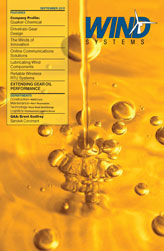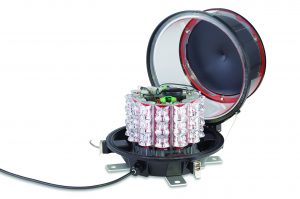Surprisingly, maintenance practices in the wind industry are still guided mostly by time-based activities. Meant to be a proactive approach to servicing multimillion-dollar equipment, the scheduled maintenance activities are performed at routine intervals, combining the most conservative engineering estimates with a bit of luck that we catch failure events before they occur. Throw in 50 percent reactive maintenance, and now you have the maintenance program for a modern wind farm.
If we believe that following the time-based maintenance program offered by the OEM is all it takes to achieve a successful 20-year operation of our wind project, we should think again. In the hierarchy of maintenance strategies, time-based maintenance—or better termed preventative maintenance (PM)—is among the least effective means of identifying when components will truly fail. Because the engineering used to determine maintenance intervals on wind turbines is based on expected component life, unpredictable and abnormal conditions that affect individual components are completely ignored in this methodology. Time-based PM can have dramatically different results at two identical turbine projects at different locations, merely because of ambient conditions such as weather, actual runtime, and project operation variables. If an oil system bypass alarm comes in intermittently before the next scheduled maintenance cycle, then it is apparent the basis of a purely time-based interval to replace the filter is inaccurate. Likewise, if you are replacing such a component prematurely, then the failure cause is probably unknown.
To appreciate the difference between simply following a scheduled maintenance program and using actual failure data to build a more predictive program, consider the light bulb. A manufacturer states that it should last a year when used every day. So just before the year is over, you decide to change the bulb. This is preventative maintenance. On the other hand, since you see this light bulb on a frequent basis, you realize that it starts to flicker around the tenth month in service. You predict that it is soon going to burn out, so you go ahead and replace it before it does. This is called predictive maintenance. Evolving your preventative maintenance program into a predictive one is not a difficult process. Some critical PM tasks should always be conservative; safety equipment inspections, fall protection devices, and emergency stop function tests should follow a rigid schedule. Reminded constantly that OEM time-based maintenance can be a flawed proposition, you can apply technical discipline when evaluating early component failures that can lead to a more predictive approach to your maintenance program.
The goal of a preventative maintenance schedule is to improve turbine reliability by periodically inspecting and replacing components before they wear out. In fact, the life of a component has absolutely nothing to do with its inspection frequency. The life of any particular component is going to be different across all of your turbines, where some seem to last forever and others may fail repeatedly and in between maintenance cycles. To reduce failures then, maintenance would have to be performed on an excessively frequent interval and well in advance of the detection of a component failure. You would likely not benefit much by increasing the frequency of preventive maintenance as a means to improve detection of component failure, as the cost of performing the maintenance activity will increase directly with frequency. Also, increased frequency of some PM activities can be detrimental. In the case of gearbox inspections and filter replacements, there is always a chance that the turbines are returned to service in a worse contaminated condition, causing a maintenance-induced failure that degrades the intent of the preventative maintenance.
In a move to predictive maintenance, your objective should be to understand the length of the time between when a problem first occurs (an intermittent oil bypass alarm) and the time for which a failure occurs (the filter is completely blinded and will compromise the system). Where an OEM scheduled maintenance plan takes only component life into account, a predictive program will include an assessment of the failure mode for each event and a determination of the period of time that is available after a problem is first discovered. This change will allow some traditional and less critical PM tasks to move from the scheduled service list to a predictive type of program. While detecting potential failure of a component from its initial indicator is a far superior program than simply using time-based inspection and replacement strategies, it isn’t enough to raise the victory flag. As each potential failure is identified, you should also determine the root cause of failure. Understanding the failure mode is critical in eliminating the cause and assuring that the failure will not occur again.
A review of your PM frequencies provides an opportunity to reduce the preventive maintenance effort while growing your maintenance program into a predictive model. It is important to understand the approach used with OEM scheduled maintenance plans and how failure detection can be applied to increase reliability and prevent undesirable turbine outages.


































